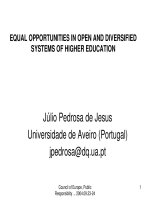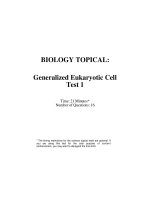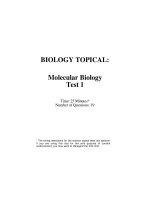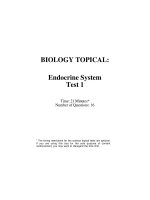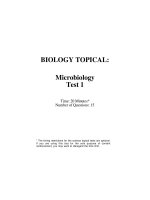9Circulatory and lymphatic systems test w solutions
Bạn đang xem bản rút gọn của tài liệu. Xem và tải ngay bản đầy đủ của tài liệu tại đây (76.68 KB, 12 trang )
BIOLOGY TOPICAL:
Circulatory and Lymphatic Systems
Test 1
Time: 23 Minutes*
Number of Questions: 18
* The timing restrictions for the science topical tests are optional. If
you are using this test for the sole purpose of content
reinforcement, you may want to disregard the time limit.
MCAT
DIRECTIONS: Most of the questions in the following
test are organized into groups, with a descriptive
passage preceding each group of questions. Study the
passage, then select the single best answer to each
question in the group. Some of the questions are not
based on a descriptive passage; you must also select the
best answer to these questions. If you are unsure of the
best answer, eliminate the choices that you know are
incorrect, then select an answer from the choices that
remain. Indicate your selection by blackening the
corresponding circle on your answer sheet. A periodic
table is provided below for your use with the questions.
PERIODIC TABLE OF THE ELEMENTS
1
H
1.0
2
He
4.0
3
Li
6.9
4
Be
9.0
5
B
10.8
6
C
12.0
7
N
14.0
8
O
16.0
9
F
19.0
10
Ne
20.2
11
Na
23.0
12
Mg
24.3
13
Al
27.0
14
Si
28.1
15
P
31.0
16
S
32.1
17
Cl
35.5
18
Ar
39.9
19
K
39.1
20
Ca
40.1
21
Sc
45.0
22
Ti
47.9
23
V
50.9
24
Cr
52.0
25
Mn
54.9
26
Fe
55.8
27
Co
58.9
28
Ni
58.7
29
Cu
63.5
30
Zn
65.4
31
Ga
69.7
32
Ge
72.6
33
As
74.9
34
Se
79.0
35
Br
79.9
36
Kr
83.8
37
Rb
85.5
38
Sr
87.6
39
Y
88.9
40
Zr
91.2
41
Nb
92.9
42
Mo
95.9
43
Tc
(98)
44
Ru
101.1
45
Rh
102.9
46
Pd
106.4
47
Ag
107.9
48
Cd
112.4
49
In
114.8
50
Sn
118.7
51
Sb
121.8
52
Te
127.6
53
I
126.9
54
Xe
131.3
55
Cs
132.9
56
Ba
137.3
57
La *
138.9
72
Hf
178.5
73
Ta
180.9
74
W
183.9
75
Re
186.2
76
Os
190.2
77
Ir
192.2
78
Pt
195.1
79
Au
197.0
80
Hg
200.6
81
Tl
204.4
82
Pb
207.2
83
Bi
209.0
84
Po
(209)
85
At
(210)
86
Rn
(222)
87
Fr
(223)
88
Ra
226.0
89
Ac †
227.0
104
Rf
(261)
105
Ha
(262)
106
Unh
(263)
107
Uns
(262)
108
Uno
(265)
109
Une
(267)
*
58
Ce
140.1
59
Pr
140.9
60
Nd
144.2
61
Pm
(145)
62
Sm
150.4
63
Eu
152.0
64
Gd
157.3
65
Tb
158.9
66
Dy
162.5
67
Ho
164.9
68
Er
167.3
69
Tm
168.9
70
Yb
173.0
71
Lu
175.0
†
90
Th
232.0
91
Pa
(231)
92
U
238.0
93
Np
(237)
94
Pu
(244)
95
Am
(243)
96
Cm
(247)
97
Bk
(247)
98
Cf
(251)
99
Es
(252)
100
Fm
(257)
101
Md
(258)
102
No
(259)
103
Lr
(260)
GO ON TO THE NEXT PAGE.
2
as developed by
Circulatory and Lymphatic Systems Test 1
Passage I (Questions 1–6)
While the coagulation factors necessary to initiate
clotting are always present in the blood, the formation of
a clot in the intact vascular system is prevented by three
properties of the vascular walls. First, the endothelial
lining is smooth enough to prevent activation of the
clotting system, which is sensitive to vascular damage.
Second, the inner surface of the endothelium is covered by
glycocalyx, a mucopolysaccharide that repels the clotting
factors and platelets in the blood. Third, an endothelial
surface protein known as thrombomodulin binds
thrombin, the enzyme that converts fibrinogen into fibrin
in the final stage of clotting. The binding of thrombin to
thrombomodulin reduces the amount of thrombin that can
participate in clotting. Also, the thrombomodulinthrombin complex activates protein C, a plasma protein
that hinders clot formation by acting as an anticoagulant.
blood trauma or
contact with collagen
XII
activated XII
XI
activated XI
Ca 2+
IX
activated IX
VIII
Ca 2+
thrombin
X
activated X
platelet
phospholipids
and factor 3
thrombin
Ca 2+
V
prothrombin
activator
prothrombin
If the endothelial surface of a vessel has been
roughened by arteriosclerosis or infection, and the
glycocalyx-thrombomodulin layer has been lost, the first
step of the intrinsic blood clotting pathway (Figure 1)
will be triggered. A protein known as Factor XII changes
shape to become “activated” Factor XII, setting off a
cascade of reactions that culminates in the formation of
thrombin and the subsequent conversion of fibrinogen to
fibrin. Simultaneously, platelets release platelet factor 3, a
lipoprotein that helps to activate the coagulation factors.
A thrombus, which is an abnormal blood clot that
develops in blood vessels, may diminish or obstruct
vascular flow. A thrombus that dislodges and travels in
the bloodstream is referred to as an embolus. Typically, an
embolus will travel through the circulatory system until it
becomes trapped at a narrow point, resulting in vessel
blockage.
thrombin
Ca 2+
fibrinogen
fibrin
Figure 1
1 . According to Figure 1, the role that Factor VIII plays
in the activation of Factor X is that of:
A.
B.
C.
D.
an enzyme.
a cofactor.
a proenzyme.
a substrate.
2 . Which of the following is most likely to be the
origin of a pulmonary embolus that blocks the
pulmonary artery?
A.
B.
C.
D.
Veins of the lower legs
Left side of the heart
Aorta
Pulmonary veins
GO ON TO THE NEXT PAGE.
KAPLAN
3
MCAT
3 . The initial formation of thrombin in the intrinsic
clotting pathway:
A . causes a deficiency of prothrombin and platelets.
B . has a positive feedback effect on thrombin
formation.
C . deactivates the blood factors.
D . enhances the conversion of Factor XII to
activated Factor XII.
4 . All of the following would cause prolonged clotting
time in a human blood sample EXCEPT:
A.
B.
C.
D.
addition of a calcium deionizing agent.
removal of Factor VIII.
addition of activated Factor X.
removal of platelets and platelet phospholipids.
5 . Based on information in the passage, which of the
following is the most likely mechanism of action of
protein C?
A.
B.
C.
D.
Negative feedback regulation of thrombomodulin
Promotion of the formation of prothrombin
Activation of Factors X and XII
Deactivation of activated Factors V and VIII
6 . Clinicians inject small quantities of heparin in
patients with a history of pulmonary emboli in order
to prevent further thrombus formation. Heparin
greatly increases the activity of antithrombin III, the
blood’s primary inhibitor of thrombin. One possible
adverse side effect of heparin administration is:
A.
B.
C.
D.
increased blood pressure.
partial destruction of existing emboli.
minor bleeding.
dizziness.
GO ON TO THE NEXT PAGE.
4
as developed by
Circulatory and Lymphatic Systems Test 1
Questions 7 through 11 are
NOT based on a descriptive
passage.
1 1 . The diagram below illustrates the relationship
between interstitial (extracellular) fluid pressure and
lymph flow. Would an increase in interstitial fluid
protein cause an increase in lymph flow?
7 . If a patient’s lymphatic channels have been obstructed
by the spread of malignant tumors, which of the
following consequences will result?
relative lymph flow
A . Increased leakage of fluid from the capillaries into
extracellular spaces
B . Decreased concentration of proteins in the
extracellular spaces
C . Increased fluid pressure in the extracellular spaces
D . Decreased risk of metastasis
20
10
1
8 . The spleen can be considered the largest lymph node,
even though it is not part of the lymphatic system.
Like all lymph nodes, the spleen:
A . acts as a blood reservoir for the circulatory
system.
B . intercepts antigenic agents in the circulating
blood.
C . is composed entirely of large aggregates of
lymphocytes.
D . contains the cells responsible for humoral and
cell-mediated immunity.
-6
-4
-2
0
2
4
interstitial fluid pressure
A . Yes, because fluid movement out of the
capillaries would increase interstitial fluid
pressure.
B . Yes, because the increased interstitial fluid
protein would reduce interstitial fluid volume.
C . No, because fluid movement into the capillaries
would decrease interstitial fluid pressure.
D . No, because the subsequent increase in interstitial
fluid pressure would reduce lymph flow.
9 . Which of the following is NOT a function of the
lymphatic system?
A . Removal of proteins from interstitial spaces
B . Absorption of fats from the gastrointestinal tract
C . Drainage of excess cerebrospinal fluid from the
brain
D . Removal and destruction of foreign particles
1 0 . B cells remain dormant in the lymph nodes and other
lymphoid tissue regions until activated by an antigen
for which the lymphocytes are specific. Once
activated, the B cells ultimately give rise to:
A.
B.
C.
D.
antibodies.
macrophages.
cytotoxic T cells.
lymphokines.
GO ON TO THE NEXT PAGE.
KAPLAN
5
MCAT
Passage II (Questions 12–18)
A condition know as persistent pulmonary
hypertension of the newborn (PPHN) is currently being
experimentally treated with inhaled nitric oxide (NO) gas..
NO is released by vascular endothelial cells, and causes
relaxation of vascular tissue via direct interaction with
vascular smooth muscle. When NO(g) is inhaled, it is
delivered directly to the pulmonary vasculature and results
in a reversal of pulmonary hypertension without affecting
systemic blood pressure.
In PPHN, increased pulmonary vascular resistance
leads to right-to-left shunting of blood through the
foramen ovale and ductus arteriosus. This right-to-left
circulation results in severe systemic hypoxemia: the
blood is not adequately oxygenated because it is not
properly transported to the lungs via the pulmonary
circulation.
time (hrs)
Figure 1 shows data from an experiment in which
patients inhaled NO(g) at the concentrations and durations
indicated. The patients in Group A and Group C were
newborns suffering from PPHN. Group A completely
recovered, while PPHN symptoms persisted in Group C.
The patient in Group B was a 5-month-old infant who
suffered from a sudden onset of unexplained PPHN.
During treatment, this patient experienced a temporary
reversal of pulmonary hypertension; the hypertension
returned immediately following treatment.
45
Group A: 6 patients
40
Group B: 1 patient
35
Group C: 3 patients
1 2 . Blood shunted in right-to-left circulation travels
directly from:
A.
B.
C.
D.
the pulmonary vein to the pulmonary artery.
the right lung to the left lung.
the superior vena cava to the aorta.
the right atrium to the left atrium.
1 3 . Right-to-left circulation of blood, which is a normal
element normal of fetal circulation in utero, does
NOT lead to oxygen depletion because:
A . very little oxygen is required by the fetus in
utero.
B . fetal blood is not oxygenated via circulation
through the pulmonary vasculature in utero.
C . sufficient oxygen is supplied by fetal cellular
respiration in utero.
D . the direction of blood flow in fetal circulation is
opposite the direction of blood flow in adult
circulation.
1 4 . Which of the following is the most likely
explanation for why Group B’s treatment was
ultimately unsuccessful?
A . The concentration of NO(g) administration was
too low.
B . The concentration of NO(g) administration was
too high.
C . The patient was not a newborn.
D . The patient had a congenital heart defect that led
to a form of PPHN.
30
25
1 5 . NO(g) would have the greatest vasodilatory effect by
direct action on the:
20
A.
B.
C.
D.
15
10
5
0
5
aorta.
glomerulus.
alveolar capillaries.
hepatic portal vein.
10 15 20 25
NO(g) concentration (ppm)
Figure 1
GO ON TO THE NEXT PAGE.
6
as developed by
Circulatory and Lymphatic Systems Test 1
1 6 . In the fetus, which of the following vessels transports
the most recently oxygenated blood?
A.
B.
C.
D.
Umbilical artery
Umbilical vein
Pulmonary artery
Pulmonary vein
1 7 . At birth, following clamping of the umbilical cord,
all of the following factors influence the stimulation
of the newborn’s first breath EXCEPT:
A . increased plasma CO2 concentration in the
newborn.
B . increased plasma pH in the newborn.
C . decreased plasma O2 concentration in the
newborn.
D . decreased body temperature in the newborn.
1 8 . In the normal newborn, the PO2 in both the
pulmonary vein and the left atrium is approximately
100 mmHg. However, in the newborn suffering from
PPHN, the PO2 in the left atrium is less than 100
mmHg. This results from all of the following
EXCEPT:
A . the movement of deoxygenated blood
foramen ovate.
B . the movement of deoxygenated blood
ductus arteriosus.
C . the movement of deoxygenated blood
ductus venosus.
D . diminished circulation through the
vasculature.
through the
through the
through the
pulmonary
END OF TEST
KAPLAN
7
MCAT
ANSWER KEY:
1.
B
6.
2.
A
7.
3.
B
8.
4.
C
9.
5.
D
10.
8
C
C
D
C
A
11.
12.
13.
14.
15.
A
D
B
D
A
16.
17.
18.
B
B
C
as developed by
Circulatory and Lymphatic Systems Test 1
CIRCULATORY AND LYMPHATIC SYSTEMS TEST 1 EXPLANATIONS
Passage I (Questions 1-6)
1.
B
According to the passage and the figure, the intrinsic clotting pathway consists of a series of reactions in which
proteins, such as Factor X, are converted from their inactive, proenzyme forms, to their active, enzyme, forms. In this step,
Factor X is the proenzyme, choice C, that is undergoing the transformation. Factor X serves as the substrate, choice D, for
activated Factor IX, which is the enzyme, choice A, that catalyzes the conversion of Factor X to its active form. So choices
A, C, and D are all incorrect. Factor VIII, Ca2+, platelet phospholipids, and factor 3 all serve as cofactors for the reaction: they
accelerate the conversion of Factor X to its active form.
2.
A
Based on the information in the last paragraph, a pulmonary embolus is an abnormal blood clot that has been
dislodged from its point of origin and carried through the circulatory system to the lungs, where it blocks the pulmonary
artery or one of its branches. Since the movement of an embolus is halted as soon as it reaches a narrow point in the system,
the number of possible areas from which a pulmonary embolism could originate is limited. The embolus couldn't, for
example, have come from the left side of the heart, choice B, because the journey through the systemic circulation to the right
side of the heart and then to the pulmonary arteries would be a virtually impossible one for the embolus to make; it would
almost certainly lodge in some systemic vessel. An embolus coming from the aorta, choice C, or the pulmonary veins,
choice D, would similarly end up lodged somewhere in a systemic vessel, perhaps in the upper limbs, the lower extremities,
or the brain. Most pulmonary emboli originate in the veins of the lower legs: they flow freely with venous blood up into the
right side of the heart and then into the pulmonary arteries, where they typically lodge.
3.
B
Although this isn't specified in Figure 1, when the cascade of reactions begins, Factor V and Factor VIII are initially
inactive because no thrombin is present. As soon as clotting begins and thrombin is formed, however, this early thrombin
activates Factors V and VIII; Factors V and VIII serve as cofactors in the reactions that activate Factor X and prothrombin
activator. Thus, thrombin itself will speed up its own synthesis. The initial formation of thrombin, therefore, has a positive
feedback effect, perpetuating a cycle of accelerated thrombin formation, and so choice B is correct. Choice A is wrong because
thrombin has no effect on the number of circulating platelets and it increases prothrombin synthesis, leading to its own
synthesis. Choice C is wrong because, as discussed, thrombin is responsible for the activation of several of the factors
involved in the clotting pathway. Choice D is wrong because it is blood trauma or contact with collagen that enhances the
activation of Factor XII.
4.
C
Prolonged clotting time would result from any sort of interference in the intrinsic pathway shown in Figure 1. A
deficiency of any of the clotting factors, including Factor VIII or a deficiency of platelets or platelet phospholipids will make
it more difficult for the blood to coagulate and for a clot to form. Therefore, choice B and choice D are wrong. Calcium ions
are required for the promotion of all but the first two reactions in the pathway, so clotting would also be slowed or prevented
entirely by reducing the calcium ion concentration in the blood with the addition of a calcium de-ionizing agent; so choice A
is wrong. However, addition of activated Factor X would not increase clotting time, since activated Factor X is one of the key
components in the intrinsic pathway. Therefore, choice C is the right answer.
5.
D
According to the passage, protein C is an anticoagulant, something that works to prevent clotting from taking place.
Choices A, B, and C are all mechanisms that would make protein C a procoagulant, not an anticoagulant. Choice A is wrong
because negative feedback regulation of thrombomodulin would serve to facilitate clotting, since thrombomodulin acts to
slow the process. Choice B and choice C are wrong since promotion of the formation of prothrombin and activation of
Factors X and XII would clearly speed clotting, as can be seen in Figure 1.
Deactivation of activated Factors V and VIII, on the other hand, would prevent thrombin from having a positive
feedback effect on its own formation, which, as discussed in the explanation to Question 3, is essential to clot formation.
Deactivation of these factors, which is the actual mechanism of protein C function, makes protein C an effective
anticoagulant. So, choice D is correct.
6.
C
KAPLAN
9
MCAT
The purpose of heparin is to prevent the formation of abnormal blood clots, and it does so, as the question stem
explains, by enhancing the activity of the anticoagulant antithrombin III. Antithrombin III interferes with the intrinsic
pathway, which means that the ability of the blood to clot is greatly reduced by heparin injection. Minor damage to the
patient's blood vessels will not be automatically repaired, as it normally is, and the patient may experience minor vascular
bleeding as a result. Therefore, choice C is correct. Choice A is wrong because interfering with a patient's blood clotting
would not be expected to increase blood pressure. Furthermore, choice D is wrong because there is no reason to believe that
the oxygen-carrying capability of the blood, or for that matter, the integrity of the blood vessels, would be compromised.
Thus, dizziness is an unlikely choice. As for choice B, existing blood clots, or emboli, must be destroyed by fibrinolytic
enzymes. Interfering with the blood clotting pathway will have no effect on clots that already exist. So, choice B is wrong.
Again, choice C is correct.
Discretes (Questions 7-11)
7.
C
The lymphatic system drains excess fluid from the (extracellular) interstitial spaces of body tissue and carries the
fluid, called lymph, to the venous system. If malignant tumors obstruct lymphatic channels, there is no way for the fluid to
drain out of the extracellular spaces. So, choice C is correct. Choice A is wrong, because as fluid accumulates in the
extracellular spaces, the increased fluid pressure there will decrease, not increase, the amount of fluid leakage from the
capillaries into the extracellular spaces. Choice B is wrong because the lymphatic system normally carries excess proteins
from the extracellular spaces back to circulation. Since the obstructed lymphatic channels cannot do this, protein
concentration in the tissue spaces will increase, not decrease. Choice D is wrong because the very fact that malignant tumors
are present in the lymphatic system means that the risk of metastasis is increased. Metastasis is the spread of a disease from
the site of origin to another part of the body.
8.
D
The spleen can be considered a large lymph node because it contains white pulp filled with B lymphocytes and T
lymphocytes, the cells responsible for humoral and cell-mediated immunity. These lymphocytes function in exactly the same
way in the spleen as they do in the lymph nodes. Therefore, choice D is correct. Contrary to choice C, though, the spleen is
not made up entirely of lymphocytes; the spleen also has venous sinuses and red pulp that serve as reservoirs for red blood
cells. So choice C is out. Choice A and choice B are wrong because the lymph nodes do not function as blood reservoirs, nor
do they intercept antigenic agents in the circulating blood.
9.
C
As was mentioned in the discussion of Question 8, the lymphatic system carries excess fluid and proteins from the
interstitial spaces back to circulation, so choice A can be eliminated since it is a function of the lymphatic system. The
lymphatics are also important in the absorption of nutrients, particularly fats, from the gastrointestinal tract via specialized
lymph vessels called lacteals. So, choice B is wrong. Choice D is wrong because the lymphatic channels carry the lymph
through lymph nodes, where it is filtered; macrophages in the lymph nodes engulf bacteria and other foreign particles.
However, the lymphatic system does not drain excess fluid from the central nervous system, from superficial portions of the
skin, from deeper peripheral nerves, or from bone. Therefore, choice C is correct.
10.
A
When exposed to a specific antigen, B cells, or B lymphocytes, differentiate and proliferate. Some become memory
cells, while others become plasma cells. The plasma cells produce antibodies that recognize and bind specifically to the
antigen that activated the original B lymphocytes. Choice A is therefore correct. Macrophages, choice B, do not originate
from lymphocytes. Cytotoxic T cells, choice C, and lymphokines, choice D, both come from T cells, or T lymphocytes, not
B lymphocytes. Cytotoxic T cells destroy antigens directly, while lymphokines, which are secreted by helper T cells, activate
other B cells, T cells, and macrophages. So choices B, C, and D are all incorrect.
11.
A
According to the diagram, lymph flow increases when interstitial fluid pressure increases. Thus, to determine whether
an increase in interstitial fluid protein would increase lymph flow, you have to determine whether an increase in interstitial
fluid protein would increase interstitial fluid pressure. Remember how osmosis works: water diffuses from a region of lower
solute concentration to a region of higher solute concentration. When proteins leak out of the capillaries into the interstitial
spaces, this makes the interstitial spaces a region of higher solute concentration. Fluid will then flow out of the capillaries
and into the interstitium, increasing both the interstitial fluid volume and the interstitial fluid pressure. So choice B is wrong.
The increase in interstitial fluid pressure then increases lymph flow (up to a point), according to the graph. So, choice D is
wrong, and choice A is correct. Choice C is wrong, because while fluid movement from the interstitial spaces into the
10
as developed by
Circulatory and Lymphatic Systems Test 1
capillaries would decrease interstitial fluid pressure, an increase in interstitial fluid protein would cause fluid movement out of
the capillaries, not into them.
Passage II (Questions 12-18)
12.
D
According to the passage, increased pulmonary vascular resistance leads to right-to-left circulation through the
foramen ovale and the ductus arteriosus in newborns suffering from PPHN. The foramen ovale is a fetal opening that connects
the right atrium with the left atrium, and the ductus arteriosus is a fetal vessel that allows blood to flow from the pulmonary
artery directly to the aorta. Both the foramen ovale and the ductus arteriosus normally close at birth due to pressure changes.
However, in newborns with PPHN, the foramen ovale and the ductus arteriosus remain open, which means that blood flows
from the right atrium directly into the left atrium and from the pulmonary artery directly into the aorta. So, choice D is
correct.
13.
B
Prior to birth, the fetal blood is oxygenated in the umbilical vasculature in the placenta, where oxygen-rich blood
from the mother's circulatory system supplies oxygen to the oxygen-depleted blood of the fetal circulatory system. In
newborns with PPHN, the persistence of right-to-left shunting of blood diverts blood flow away from the lungs, resulting in
oxygen deprivation. Thus, choice B is correct. Choice A is wrong because there is no reason to believe that the fetus has low
oxygen demands. Even though the fetus is living within the mother's body, it still has the same energy requirements that
other living organisms have, and most energy requiring processes in the human rely on oxygen. Choice C confuses
respiration at the level of the lungs with the respiration that occurs at the cellular level in the mitochondria. The respiratory
system uptakes oxygen from the environment, and the circulatory system transports it to the cells of the body, where it is
used for cellular respiration. Choice C is incorrect because cellular respiration does not supply oxygen, it consumes oxygen.
Choice D is simply a false statement. The direction of blood flow in fetal circulation is the same as in adult circulation.
14.
D
First let's compare the data in Figure 1 for Group A and Group B. Group A patients permanently recovered from
PPHN symptoms following a 25-hour treatment with a NO(g) concentration of 6 ppm. However, the 5-month-old patient in
Group B only transiently recovered from the PPHN symptoms following a 45-hour treatment with a NO(g) concentration of 7
ppm. Because Group A and Group B patients received almost the same NO(g) concentration, although for different durations,
it cannot be concluded that the NO(g) concentration given to Group B was responsible for the failure to recover. Thus both
choice A and choice B are incorrect. Choice C is incorrect because although it is true that the patient in Group B was not a
newborn, or at least not as newly born as the other patients, this is not the best explanation for why treatment was
unsuccessful. Choice D, on the other hand, is a likely explanation: A congenital heart defect, such the failure of the ductus
arteriosus to close (patent ductus arteriosus), would account for the PPHN symptoms in a 5-month-old, and would explain
why the response to NO (g) treatment was only transitory. So, choice D is correct.
15.
A
According to the passage, NO causes relaxation of vascular tissue via direct interaction with vascular smooth muscle.
Therefore, vessels containing the greatest amount of smooth muscle would have the greatest response to NO. Artery walls are
composed of thick smooth muscle; vein walls have less smooth muscles than artery walls; and capillary walls have no
smooth muscle at all--they're composed of a single layer of endothelial cells. Choice A is correct because the aorta is the
largest systemic artery. It receives blood from the left ventricle of the heart. Choice B is incorrect because the glomerulus is a
renal structure composed of capillaries. The glomerulus is located within Bowman's capsule of a nephron and is the site of
plasma filtration. Choice C is incorrect because the alveolar capillaries are also obviously capillaries. The alveolar capillaries
are located in the alveoli of the lungs and are the site of respiratory gas exchange. Choice D is incorrect because the hepatic
portal vein, being a vein, has less smooth muscle than the aorta, and thus would not be as greatly affected by NO as the aorta.
The hepatic portal vein carries blood from capillary networks of the stomach, intestines, pancreas, and spleen to a capillary
network in the liver before this blood is transported to the heart.
16.
B
Prior to birth, the fetal blood is oxygenated in the umbilical vasculature in the placenta, where oxygen-rich blood
from the mother's circulatory system supplies oxygen to the oxygen-depleted blood of the fetal circulatory system. The
mother's circulatory system can be considered the external environment with respect to the fetus. One usually thinks of
arteries as carrying oxygenated blood away from the heart and veins as carrying deoxygenated blood to the heart. However, in
the case of the adult pulmonary vasculature, and the fetal umbilical vasculature, veins carry oxygenated blood to the heart and
KAPLAN
11
MCAT
arteries carry deoxygenated blood away from the heart. Thus, the fetal umbilical vein and adult pulmonary vein carry freshly
oxygenated blood to the heart, and the fetal umbilical artery and adult pulmonary artery carry deoxygenated blood away from
the heart. The pulmonary vasculature does not become the site of blood oxygenation until birth, when the newborn first starts
to breathe air into the lungs. Therefore, choice A, choice C, and choice D, are wrong, and choice B is correct.
17.
B
Because this is an EXCEPT question, you need to determine which factor will not stimulate respiration in the
newborn. You need to think about the kinds of physiological signals that trigger an increase in respiration and also trigger the
newborn to take its first breath. The chemical factors in the blood that affect the breathing rate are CO2, H+, and O 2. When O2
levels are low, or when CO2 and H+ levels are high, the breathing rate will increase. Remember the carbonic acid equation:
CO2 combined with water will yield carbonic acid (H2 CO3), which further dissociates into H+ (protons) and bicarbonate ion
(HCO3 ). An increase in CO2 concentration will push the equation to the right, thus yielding more H+, and thus a drop in pH.
The body will try to compensate by breathing off CO2 in order to reduce the H+ concentration in the blood and rectify this pH
imbalance. So an increase in CO2 concentration, which yields an increase in H+, results in an increased respiration rate. So at
this point we can see that an increased plasma pH, which results from a decreased plasma H+ concentration, would not lead to
an increase in respiration and thus B is the correct answer.
Let's think for a moment about the physiological conditions that exist in the newborn before it takes its first breath.
The respiratory function of the placenta is terminated or declining in the newborn, so prior to the first breath the newborn will
have increased plasma CO2 levels and decreased plasma O2 levels, which stimulate respiration. Furthermore, the newborn is
subject to significant heat loss following removal from the warm environment provided by the mother's body. While it is
theorized that the decreased body temperature of the newborn is one of the physiological triggers leading to the first breath, the
mechanism of this response is unknown. Thus, the conditions described in choice A, choice C, and choice D all exist in the
newborn and do stimulate the newborn's first breath.
18.
C
Since this is an EXCEPT question, you're looking for the answer that does not explain why the newborn with
PPHN has a PO2 in the left atrium that is less than 100 mmHg. You should remember that both the adult pulmonary vein
and the newborn pulmonary vein carry oxygenated blood that has just come form the lungs to the left atrium. Therefore, any
factor that decreases the flow of blood to the lungs will decrease the degree of oxygenation of the blood in the left atrium. As
discussed in the explanations to Questions 12 and 13, the newborn suffering from PPHN experiences a right-to-left shunting
of blood through the foramen ovale and ductus arteriosus, which leads to diminished flow of blood to the lungs. You can
therefore conclude that choice A, choice B, and choice D are all wrong, because each one describes circulation pathways
present in PPHN that lead to diminished blood flow through the pulmonary vasculature, and thus lead to a lower PO2 in the
left atrial blood. Choice C is correct because the ductus venosus is a fetal duct that is not involved in the shunting of blood
away from the lung. This duct shunts blood from the umbilical vein to the inferior vena cava, thereby bypassing the liver.
12
as developed by

